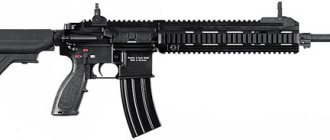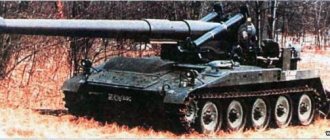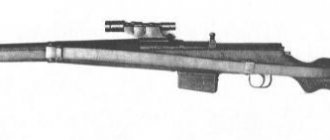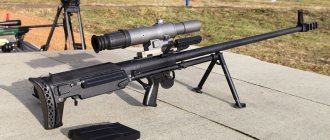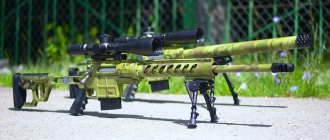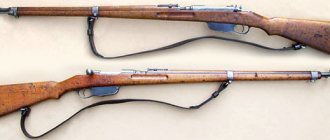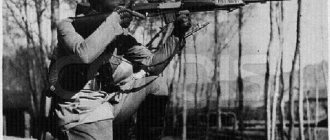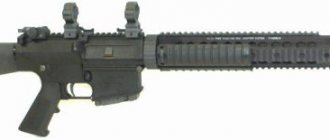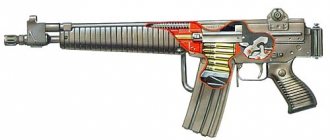Murata rifle: from the first samples to a rifle with a middle magazine
Initially, Japan, whose industrial development after the Meiji Revolution was catching up, was forced to purchase rifles from European countries, until in 1880 it adopted its own single-shot Murata rifle chambered for black powder. The further evolution of Japanese small arms followed the already beaten path of Europe - the transformation of a single-shot model into a repeating rifle. Thus, the Murat rifle received an eight-round under-barrel magazine. As a temporary measure, this was completely justified both militarily and economically. It was easier and cheaper to modernize an existing model than to create a new one in conditions of very rapid aging of small arms.
The Murata rifle became the main weapon of the Japanese army in the war with China in 1894-1895. Meanwhile, a number of armies around the world began to adopt models with a middle magazine, which was filled using a clip or a pack. In this direction, further modernization of the Murata rifle was not justified - the adoption of a fundamentally new model was required. And such a weapon was the Arisaka rifle of the 1897 model.
Options and modifications[edit]
- Type 13
(1880) - prototype model of 11 × 60 caliber. Single-shot bolt-action rifle. - Type 16
(1883) - carbine, the device completely copies Type 13. - Type 18
(1885) - final model, improved ergonomics and mechanics. Caliber 11×60 mm. - Type 22
(1889) - repeating rifle chambered for a reduced caliber 8×53. Under-barrel magazine, eight-round. - Type 22 (carbine)
- carbine, under-barrel magazine with a capacity of five rounds. - Civilian models (various) - mostly decommissioned Type 13 and Type 18, converted into shotguns by removing the bayonet mount and rifling in the barrel. Removal of the buttstock was common, although some civilian versions retained the authentic appearance and design.
Features of the Arisaka rifle
The creator of the rifle, whose name it received, was the colonel, and later also the general, Nariake Arisaka. Along with Italy, Japan adopted the rifle chambered for a reduced caliber - only 6.5 mm. The military, as a rule, was distrustful of the reduction in caliber, but on the battlefield the 6.5 mm cartridge was quite enough to destroy manpower. At the same time, there were a number of noticeable advantages - relatively low recoil when firing and, accordingly, a smaller mass of portable ammunition with an equal number of cartridges. In addition, the weapon was distinguished by high shooting accuracy.
The creator of the rifle is Colonel Arisaka. (Pinterest)
The Arisaka rifle had a clip-on loading system with a staggered arrangement of cartridges in the magazine. In case of hand-to-hand combat, the weapon was equipped with a very impressive blade-type bayonet. Taking into account the Russo-Japanese War, where a number of shortcomings were revealed, some changes were made to the design of the rifle. First of all, the sights and rifle bolt underwent modernization. In addition, in 1906, the Japanese army switched to using a new cartridge with a pointed bullet.
Subsequently, the Arisaka rifle was modernized several times. A description of all types of rifles and carbines created on its basis may be the topic of a separate study. Let us only note that the fundamental difference between the rifles produced since the late 1930s was the transition to a new 7.7 mm caliber. This rifle was produced in several versions, differing in length and scope. Carbines differed from rifles in length and, in some cases, in the presence of a folding needle bayonet. The total production of Arisaka rifles amounted to about 3.5 million units - this is relatively little and indicates that the weapon was produced primarily for the needs of its own army. At the same time, the main losses of small arms for Japan occurred during the Second World War and there was no need to produce rifles in tens of millions.
Marking
Example Imperial Chrysanthemum - A seal indicating that the weapon is the personal property of Tenno. The pistol pictured is an Arisaka type 99. The chrysanthemums on the Murata rifles were much smaller.
Murata rifles have numerous markings or stamps, as was common on most Imperial Japanese weapons. The following marks are on the Type 18 rifle:
- To the right of the bolt lock: Meiji
(Aga 明治
Meiji
)
13
respectively.
18
respectively.
22 years old - Between slide and barrel: Imperial Chrysanthemum
(as a sign that the weapon is Tenno's personal property) - Front left barrel: serial number (inch Arabic numerals)
- Front left barrel: Empire of Great Japan Murata pistol
(all in kanji) - Run forward to the left: Manufacturing Arsenal Manufacturing location
(all in kanji)
Please note Imperial Chrysanthemum
after the corresponding weapon was no longer used by the Imperial Army,
X
was stamped.
In Russian service: from the First to the Second World War
In the Russian Empire during the First World War, the army from the very beginning experienced an acute shortage of weapons. This also affected rifles. Since in 1914 domestic enterprises could not quickly make up for the huge loss of small arms on the battlefields, a decision was made to purchase foreign models from the USA, France and Japan. Some of these weapons were obsolete and were sent to the rear units.
Russian soldiers with an Arisaka rifle. (Pinterest)
Rifles of both the 1905 model and the 1897 model were supplied from Japan. The Japanese got rid of obsolete and worn-out rifles of the 1897 model quite cheaply. Since the purchase of cartridges was intermittent, it was decided to establish its own production of 6.5 mm cartridges at the Petrograd Armory factory The production of 200 thousand units per month did not cover the entire consumption of ammunition, but together with purchases in Japan and England, it even made it possible to create some reserves by 1917. In total, at least 750 thousand Arisaka rifles entered the Russian army and navy. Moreover, most of the Japanese rifles ended up in the troops of the Northern Front. The Japanese army itself, whose actions in the First World War were very limited, did not lack weapons.
Under the Japanese cartridge of the Arisaka rifle, the famous Fedorov assault rifle was also designed during the First World War. After the end of the Civil War, a significant number of Japanese rifles remained in Soviet Russia, which for some time were still found in the army and territorial units. Subsequently, due to the unification of weapons and the lack of a significant number of cartridges, these weapons ended up in warehouses, and then found themselves in demand during the Great Patriotic War. Relatively few Arisaka rifles were used by militias and fighter battalion personnel. True, this time the crisis with small arms turned out to be short-lived; by 1942, the Arisaka rifle was seen on the Soviet-German front and in the rear less and less often.
story
During the Second Sino-Japanese War in the 1930s, the Japanese soon discovered that the 7.7 mm cartridge fired their Type 92 heavy machine gun in China was superior to the 6.5×50 mm cartridge Type 38 rifle, necessitating the development of new weapons to replaced by the superior Type 38. The Imperial Japanese Army (IJA) developed the Type 99 based on the Type 38 rifle but with a 7.7mm caliber.
The Type 99 was produced in nine different arsenals. Seven arsenals are located in Japan, with the other two located at Mukden in China and Jinsen in Korea. The IJA intended to completely replace the Type 38 with the Type 99 before the end of the war. However, the outbreak of the Pacific War never allowed the Army to completely replace the Type 38 and so the IJAs were used as rifles during the war. As the war progressed, more and more cost-cutting steps were introduced in order to speed up production. Late war rifles were often called "Last Ditch" or "Spare Standard" due to their rough finish. They are usually as oil as a 1945 Mauser K98k from Germany, or worse.
The Type 99 was produced in four versions, the regular release Type 99 Choke, the Type 99 Long Rifle (limited production variant), the Takedown Type 2 Parachute Rifle, and the Type 99 Sniper Rifle. The standard rifle also comes with a wire monopod and an anti-aircraft sighting device. The Type 99 was the first mass-produced infantry rifle to have a chrome-lined opening for ease of cleaning. All of these functions were abandoned mid-war.
Nomenclature Note: In the West, Japanese equipment is usually called "Type XX" rather than "Model XX". In the case of firearms, "Model" is a more accurate interpretation of the SHIKI (式) character, but the word "type" has become established among collectors for decades.
Other users
During the Korean War, approximately 126,500 short and 6,650 long Type 99 rifles were re-chambered under American direction at the Tokyo Arsenal to fire the then standard .30-06 Springfield cartridge. Apparently intended for the South Korean "gendarmerie", several shotguns apparently issued late in the war in 1953 were fitted with an extended magazine well and had a small notch in the top of the receiver to accommodate 1/3 inch over the 30-inch length. 06th round. Accuracy suffers due to differences in cartridges, speeds and rifling characteristics, but they are nonetheless functional. Conversions to both the 30-06 and 7.62 NATO, and the 7.62 Russian were also carried out by civilians, often along with sporterising changes.
After 1946, the Republic of China again chambered a large number of Type 99 rifles, firing the 8×57 IS cartridge. Indonesian forces used large numbers of Type 99 rifles in combat against the Dutch during the Indonesian National Revolution (1945-1949). The Royal Thai Army received Japanese rifles of all types after 1945 and converted the short-lived Type 99 rifles to fire the US .30-06 cartridge during the early 1950s.
Captured rifles
In addition to deliveries to the First World War, another category of Arisaka rifles that ended up in Russia and the USSR was captured weapons. If the events at Khasan in 1938 did not bring the Red Army significant trophies, then a year later 5,380 Japanese rifles were taken at Khalkhin Gol. The Soviet-Japanese War brought even more trophies, when in August-September 1945 a huge amount of small arms was received. The Red Army no longer needed Japanese rifles in 1945 - the age of repeating rifles was coming to an end. Therefore, a significant mass of captured weapons was transferred to the communist forces of China and found use during the civil war of 1946-1950.
Red Army soldiers with Arisaka rifles. (Pinterest)
In Russian fiction, the Arisaka rifle and carbine are found in a number of books, the plot of which is related to the events of the Civil War and, less commonly, the Soviet-Japanese War. The rifle itself can be found in large museum collections.
web links
- Murata rifles.
Nambu World: World War II Japanese Teri Pistol Website, Retrieved July 24, 2015 (English). - Murata Type 13 Rifle.
Nambu World: World War II Japanese Teri Pistol Website, Retrieved July 24, 2015 (English). - Murata Type 18 Rifle.
Nambu World: World War II Japanese Teri Pistol Website, Retrieved July 24, 2015 (English). - Murata Type 22 Rifle.
Nambu World: World War II Japanese Teri Pistol Website, Retrieved July 24, 2015 (English). - Murat's guns.
Nambu World: World War II Japanese Teri Pistol Website, Retrieved July 24, 2015 (English). - Bayonets for Murat's rifle.
Nambu World: World War II Japanese Teri Pistol Website, Retrieved July 24, 2015 (English). - Japanese Type 18 Murata in RIA.
ForgottenWeapons.com, Retrieved July 24, 2015 (English). - Type 18 Murata in RIA.
ForgottenWeapons.com, Retrieved July 24, 2015 (English).
models
Type 30
The first rifle of the Arisaka series. Chambered 6.5 × 50mmSR Type 30. 554,000 built.
Type 35
Officially designated Type 35 dark rifle
. Also in 6.5×50mmSR Type 30.
Improvement of a design based on the Type 30 for the Imperial Japanese Navy Land Forces by Major Nambu Kijirō. Changes include a tangent type rear sight, a separate sliding bolt cap (as opposed to simultaneous moving of them on all other types after) of the same type later used on the Siamese Mauser style rifle, the safety hook replaced by a large cocking handle part to protect against gases in case of primer inflation, a larger handle bolt handle, an improved bolt head, a gas port in the body of the bolt, and an improved chamber configuration for better cartridge feeding.
Type 38
Designed by Large Namba Kijirō. Cartridge in 6.5×50mmSR Type 38, Type 30 Cartridge can also be used. The short version exists for ease of handling and is the same length as the base rifle and carbine.
One of the most produced and frequently encountered models. Designed in 1905 and simultaneously not produced until 1942 with 3,400,000 built.
Type 38 carbine
Carbine variant type 38; 300 mm shorter. Technical personnel were also exhibited.
TYPE 44
The carbine comes from the Type 38 rifle. Cartridge in 6.5×50mmSR Type 38, Type 30 Cartridge can also be used. Distinctive features of its folding bayonet spike and two-section for cleaning takedown rods hidden in the butt. Originally intended for cavalry, also used by other support personnel.
Type 97 sniper rifle
One of the two main sniper rifles in Imperial military service. Based on the Type 38 rifle. Chambered 6.5×50mmSR Type 38, but most commonly used remanufactured charge cartridges
Associated with the Type 11 and light machine guns for lighter recoil, reduced report, masked muzzle flash, and overall accuracy. Use a factory reset Type 97 telescopic sight (2.5x).
About 22,500 built.
Type 99
Successor to the Type 38 rifle. Chambered in 7.7×58mm Type 99, later rimmed Type 92 and 97 cartridges are also usable.
Designed in 1939 and then produced and fielded from 1941 to 1945, the Type 99 was the most common Japanese Imperial service rifle during World War II and the second most produced Imperial rifle with 2,500,000 built. Significant changes are the improvement of the rear sight sight transition from a V-notch type, like those on the Type 38, to an opening, the front sight blade was reverted to a triangular shape, chrome barrels were used, and on earlier productions, the rear sight was fitted with anti-aircraft calipers .
Sub-variations included the long rifle (only about 38,000 were made) and the short shotgun; the former being 1258 mm in total and the last one being 1118 mm. Short rifles also vary in quality from entry-level, average, to last drop of blood.
Type 99 sniper rifle
Another Imperial Japanese Military sniper rifle. Built on both long and short models with the latter being higher in numbers. Chambered in 7.7×58mm Type 99, later rimmed Type 92 and 97 cartridges are also usable. The larger, more powerful caliber allowed ballistics to be less affected by windage due to strong recoil. Two different types of scopes were issued to the rifle: the Type 97 2.5X telescopic scope, or the 4X telescopic Type 99 frame. Later Type 99 scope setups are allowed for distance adjustments. Each scope was issued with its holster, and often came off the rifle and stowed in them when advancing.
According to doctrine, the snipers of the imperial military were selected by his skill in shooting and the caliber of rifle he was assigned corresponded with the ammunition company he was under.
Production began in May 1942. The total number was approximately 10,000.
TERA
A small series of rifles produced by removing materials for the Imperial Army Paratroopers and the Imperial Navy Paratroopers. The only production model is Type 2 based on Type 99 fitting; the other two types are proto-test (type 100 and type 1). Type 2 chambered in 7.7×58mm Type 99, later rimless variants from Type 92 and 97 cartridges can also be used.
Type 2 is allowed for compact storage, divided into two parts: the stock and action, and the barrel and handguard.
About a total of 19,000 were produced from 1942 to 1944.
story
The Arisaka rifle was designed by Colonel Arisaka Nariakira (有坂成章; 1852–1915), who was subsequently promoted to lieutenant general and also given the title of baron by Emperor Meiji, in 1907. During the various wars, several productions operated and variants were made. including the transition from the 6.5 mm Type 38 cartridge to the larger 7.7 mm Type 99, and the introduction of a paratrooper rifle that could be disassembled into two main parts for airborne operations. Tests on samples of Arisaka rifles carried out after the war showed that their bolts and receivers were made of carbon steel, a similar grade of SAE No. 1085 with a carbon content of 0.80% to 0.90%, and a manganese content of 0.60% to 0.90%." During destructive tests, the Arisakas were shown to be stronger than the M1903 Springfield, Lee-Enfield, and Mauser rifles. The Arisaka was also one of the few guns of the era to use barrels rather than the more traditional lands and grooves.
Some of the early release Type 99 rifles were equipped with a folding wire monopod designed to improve accuracy in the prone position. The rear sights also featured folding horizontal extensions to give a degree of lead suitable for aircraft shooting. Towards the end of World War II, last-ditch ersatz models were made in various cost-cutting variations of objects with the aim of cheaply strengthening the Imperial military; for example, the egg-shaped bulb-shaped bolt of the early experiments was replaced by a smaller and utilitarian cylindrical shape, the barrel handguard was lowered, and crude fixed sights were installed.
A Type 38 with its imperial seal intact
The Arisaka service breech rifle is commonly used by the Imperial Japanese Army and the Imperial Japanese Navy. Before World War II, Arisakas were used by the British Navy and the Russian Army, in Finland and Albania. The Czech legions that fought in the Russian Revolution were almost entirely armed with the type 30s and 38s. Many captured Arisak rifles were used by neighboring countries both during and after World War II, in places such as China, Thailand and Cambodia. However, after Japan's surrender in the summer of 1945, production of rifles and ammunition came to an abrupt halt, and Arisak quickly became obsolete. Since most of the Japanese Imperial Armory's contents were abandoned in Tokyo Harbor after the signing of the surrender, spare ammunition also became rare. Additional 6.5×50mmSR ammunition, however, is produced in China for use in their captured rifles.
A Type 99 with imperial soil compaction
Imperial seal of authorship, 16 petals of a chrysanthemum known as the Chrysanthemum Flower Seal stamped on the top of the receiver on all official Imperial issue rifles, often obliterated by filing, crushing or stamping on surviving examples. There are conflicting claims that this was done on orders from the Imperial Japanese military prior to the surrender, however it is generally accepted by most historians that the Imperial Chrysanthemums were ground down rifles on orders from General Douglas MacArthur, commander of the occupation forces at the time. To date, no documentation from either Japanese or American forces has been established that required the defacement. Most Arisakas with living marks are in Japan, although there are a few remaining on examples taken as war spoils before surrender, as well as those captured by Chinese forces. Some of the captured Chinese Arisakas were later exported to the US, including examples of a range of Type 38 carbines rebarrelled and rechambered for the 7.62×39mm round. Some Type 38 rifles captured by Kuomintang forces were also converted to fire the 7.92×57mm Mauser round.
Many of the Chrysanthemum Seals were completely ground down, but some were simply worn down with a chisel, scratched, or had the number "0" stamped several times along the edges. The latter is usually done with rifles removed from Japanese military service (and thus no longer the property of the Emperor), including rifles provided to schools or sold to other countries, such as the British Royal Navy's purchase of many Type 38s World War I's effort to release SMLE rifles for its ground forces.
A very small run of Type 38 rifles were also produced for export to Mexico in 1910, with the Mexican coat of arms in place of the imperial chrysanthemum, although few arrived before the Mexican Revolution and the bulk remained in Japan until World War I, when they were sold to Tsarist Russia.
Bayonets
Type 30
Created at the same time as the Type 30 rifle, this bayonet-type sword is compatible with all variants of the Arisaka rifle except for the Type 44. There are twenty different options, and are further classified into early, middle and late war production stages. Also fixed on Type 96 and light machine guns.
Type 35 bayonet
The Type 35 bayonet was a slightly modified 30 bayonet type, specifically designed for the Type 35 rifle. The dimensions of the bayonet are almost exactly the same as the Type 30 bayonet. The only real difference between the two is the added addition of a sprung catch that hooks into the sheath when not in use.
About 8,400,000 were made.
Type 44
Fixed permanently on Type 44 carbines, this bayonet-type stud folds under the forend and does not interfere with the barrel when deployed.
Type 2
Since the long length of the TYPE 30 is unsuitable for concealment in a paratrooper's set of personal equipment, this bayonet-type knife was created to solve this problem. Twenty centimeters shorter than the Type 30, its overall length is 32.3 cm. Used primarily with the Type 2 TERA rifle or Type 100 submachine gun by Imperial Military Airborne departments.
About 25 thousand were made.
History of creation
The war revealed numerous shortcomings in the Arisaka 1897 rifle. It turned out that during the war, the Manchurian dusty winds caused a lot of dust and contaminated the shutter mechanism; In order for the rifle to function smoothly, it was necessary to frequently disassemble and clean the bolt. The sighting frame often became confused and deformed. It turned out to be inconvenient to operate the fuse by grasping it by the hook, especially when acting in a hurry. Disassembling and reassembling the bolt was difficult. There were demands to strengthen the ejector and feed spring, as well as to prevent the loss of the magazine box cover. The Japanese decided to immediately eliminate the noticed shortcomings.
